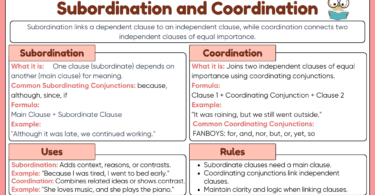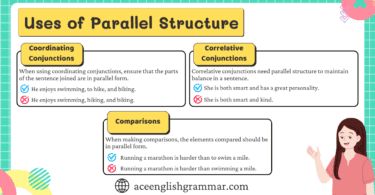Subject-verb agreement means the subject and verb in a sentence must match in number (singular or plural) and person. A singular subject takes a singular verb, and a plural subject takes a plural verb. This post helps learn the basic rules and exceptions of subject-verb agreement for writing correct, clear English sentences.
Table of Contents
What is subject-verb Agreement?
Subject-verb agreement is a grammatical rule that ensures that the subject of a sentence (the person, place, thing, or idea that the sentence is about) and the verb (the action or state of being) used to describe that subject match in terms of number (singular or plural) and persons (1st, 2nd or 3rd person). In other words, if the subject is singular, the verb should be singular, and if the subject is plural, the verb should be plural. For example:
- She plays the piano. ✅
In this sentence, “She” is a singular subject, and the verb “plays” is also singular. They agree in number.
- They is coming to the party. ❎
Here “They” is a plural subject, but the verb “is” is singular. This is a subject-verb disagreement. It should be “They are coming to the party.”
- The dogs bark ✅
In this sentence, “The dogs” is a plural subject, and the verb “bark” is also plural. They agree in number.
Rules of Subject-Verb Agreement with Examples
Here are some basic rules for subject-verb agreement:
1. Basic Rule
Singular subjects take singular verbs, whereas plural subjects take plural verbs.
Examples:
- She is going to the store. (Singular subject)
- They are going to the store. (Plural subject)
2. Singular Subjects with Singular Verbs
When the subject of a sentence is singular (referring to one person, thing, or concept), the verb must also be singular.
Example: He plays cricket.
Here, “He” (singular subject) is paired with “plays” (singular verb).
3. Plural Subjects with Plural Verbs
When the subject of a sentence is plural (referring to more than one person, thing, or concept), the verb must also be plural.
Example: They sing a song.
Here, “They” (plural subject) is paired with “sing” (plural verb).
4. Compound Subjects
When a sentence has a compound subject (two or more subjects connected by “and”), the verb should be plural.
Example: Tom and Jerry are friends.
Here, “Tom” and “Jerry” (plural subjects) are paired with the plural verb “are.”
5. Collective Nouns
Collective nouns represent groups or collections of people or things (e.g., team, family, and committee). Whether you use a singular or plural verb with collective nouns depends on the context.
If the group is acting as a single unit, use a singular verb.
Example: The team is practicing. (As a unit)
If the emphasis is on individual members of the group, use a plural verb.
Example: The team are arguing among themselves.” (As an Individual)
6. Indefinite Pronouns
Some indefinite pronouns, such as “everyone,” “nobody,” and “everything,” are always singular. Use singular verbs with them.
Example: Everyone is here. (Singular)
Others, like “both,” “several,” “some,” and “many,” are plural and require plural verbs.
Example: Some are missing. (Plural)
7. Subjects Joined by “or” or “nor”
When two subjects are joined by “or” or “nor,” use the verb that agrees with the subject closest to the verb.
Example: Neither the cat nor the dog is mine.
(Here Singular verb “is” because “dog” is closer to the verb)
8. Subjects Joined by “either/or” or “neither/nor”
When using “either/or” or “neither/nor,” the verb should agree with the subject closest to it.
Example: Either the students or the teacher has the answer.
9. Quantifiers
Quantifiers like “each,” “every,” and “many a” are considered singular and should be paired with singular verbs.
Example: Every student has a textbook.
10. Subjects that Appear Singular but Are Plural:
Some nouns that appear singular are actually plural and require a plural verb. These include “scissors,” “pants,” “glasses,” and “politics.”
Example: These scissors are sharp.
11. Inverted Sentences
In questions and sentences that start with “there” or “here,” the verb still agrees with the subject, not the word “there” or “here.”
Examples: Here is your gift.
There are many books on the shelf.
(Here the subject “books” is plural, so the plural verb “are” is used.)
12. Words between subject and verb
Words or phrases that come between the subject and verb do not affect the agreement.
Example: The book on the table belongs to me.
13. Uncountable nouns:
Uncountable nouns (e.g., water, rice) are always treated as singular and take singular verbs.
Example: Water is essential for life.
14. Relative Pronouns
A relative pronoun (who, which, that) as the subject of a verb is always followed by a singular verb, even if the relative pronoun refers to a plural noun.
Example: The students who study hard usually perform well.
(Relative pronoun “who” is followed by a singular verb “study”.)
15. Wishes and requests
In sentences expressing wishes or requests, verbs may follow specific patterns:
Expressing wishes:
Use “were” (even for singular subjects) instead of “was” when expressing hypothetical or unreal situations.
Example: I wish I were a millionaire.
Making requests:
Use the base form of the verb (infinitive) after certain phrases like “request that,” “ask that,” or “suggest that.”
Example: We request that you complete the form.
Making polite requests:
Use modal verbs like “could,” “would,” or “please” to make requests more polite.
Example: Could you please pass the keys?
FAQs
Q1. What is subject-verb agreement?
Subject-verb agreement is a grammatical rule that ensures that the subject (the doer of the action) and the verb (the action or state of being) in a sentence match in number (singular or plural).
Q2. How do I determine whether a subject is singular or plural?
A singular subject refers to one person, place, thing, or idea, while a plural subject refers to more than one. For example, “cat” is singular, and “cats” is plural.
Q3. Do collective nouns take singular or plural verbs?
Collective nouns, like “team” or “family,” can take either singular or plural verbs depending on whether you’re referring to the group as a whole or its individual members. For example, “The team is playing well” (singular) or “The team are arguing among themselves” (plural).
Q4. What verb should I use when subjects are connected by “or” or “nor”?
Use a singular verb if the nearest subject is singular, and use a plural verb if the nearest subject is plural. Example: “Neither the cat nor the dogs are” or “Neither the cats nor the dog is.”
Q5. Give some examples of subject-verb agreement.
Here are some examples of subject-verb agreement:
- She plays the piano beautifully.
- They have already left for the airport.
- The students are studying for their exams.
- He runs every morning before work.
- The car needs a new battery.
- The flowers bloom in the springtime.
Read More




Leave a Comment